Wildlife watching can unexpectedly boost your mental clarity, reduce stress, and deepen your bond with nature. It encourages mindfulness, sharpens your focus, and inspires creativity through unique sights and sounds. Plus, it promotes physical activity, builds patience, and strengthens community ties with fellow enthusiasts. By engaging with wildlife, you open personal growth and fulfilling experiences you might not have anticipated. Keep exploring, and you’ll discover even more ways it can enrich your life.
Key Takeaways
- Enhances mental clarity and reduces stress through mindfulness and exposure to natural environments.
- Fosters connections with nature, promoting conservation awareness and eco-friendly behaviors.
- Develops patience, focus, and observational skills that boost personal growth and character.
- Inspires creativity and artistic expression by capturing wildlife’s colors, movements, and behaviors.
- Builds community through shared experiences, group activities, and collaborative conservation efforts.
Enhancing Mental Clarity and Reducing Stress

Spending time in nature, especially while wildlife watching, can considerably boost your mental clarity and help reduce stress. As you observe animals in their natural habitat, you naturally engage in mindfulness meditation, focusing your attention on the present moment. This mindful awareness sharpens your cognitive enhancement, clearing mental clutter and improving focus. The peaceful environment encourages relaxation, lowering cortisol levels and easing anxiety. Wildlife watching provides a calming backdrop that allows your mind to reset and rejuvenate. Additionally, sound vibrations from natural surroundings can influence brainwave patterns, further enhancing your relaxation and mental clarity. Research indicates that exposure to natural contrast ratios can positively affect your mood and overall mental health. The diversity of sights and sounds in nature stimulates your senses, promoting neuroplasticity and mental agility. Enhanced mental clarity can also lead to improved decision-making and problem-solving skills, enriching both your personal and professional life. Engaging regularly in these activities can boost cognitive function, strengthening your ability to think clearly and adapt to challenges.
Fostering a Deeper Connection With Nature
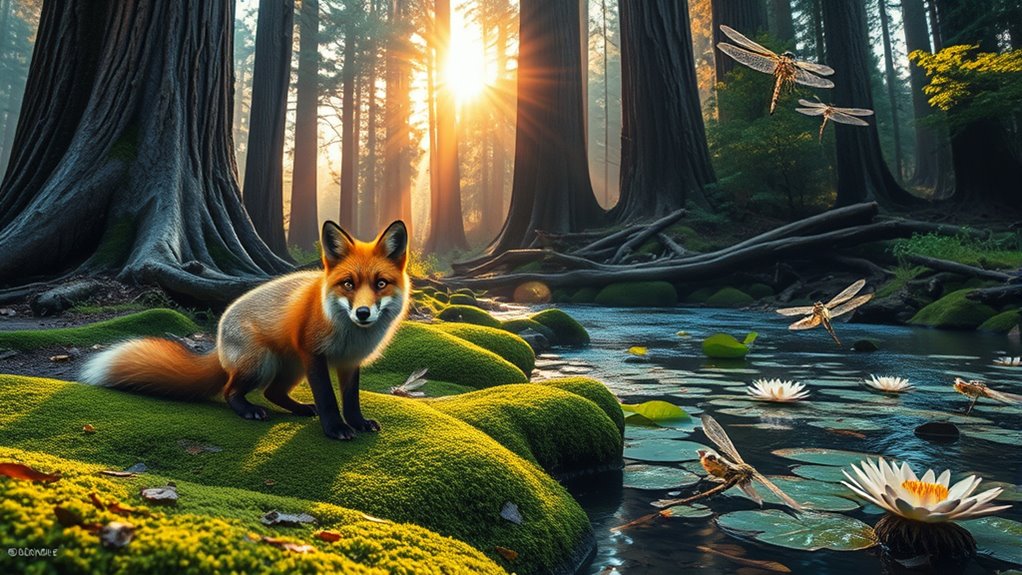
As you spend time observing wildlife in their natural environment, you naturally cultivate a deeper connection with nature. This experience encourages you to adopt sustainable practices and boosts conservation awareness. To strengthen this bond, consider:
- Learning about local ecosystems to understand how your actions impact wildlife. Incorporating sustainable habits into your routine can help minimize negative effects on habitats.
- Supporting conservation efforts that protect habitats and species.
- Practicing responsible wildlife watching by maintaining a respectful distance and avoiding disturbance. Understanding float mounting textile art techniques can also inspire you to appreciate detailed craftsmanship in natural objects.
- Exploring habitat preservation initiatives to contribute to the longevity of local ecosystems. Recognizing the importance of early detection and intervention in health issues like breast cancer symptoms can also inspire a proactive attitude toward overall well-being.
- Engaging with educational programs that highlight the significance of biodiversity and how it sustains ecosystems.
These habits help you appreciate the intricate balance of nature and foster a sense of responsibility. By engaging directly with wildlife, you develop empathy for animals and a commitment to preserving their environment. This deeper connection not only enriches your experience but also motivates you to act consciously in everyday life.
Boosting Physical Activity and Overall Fitness
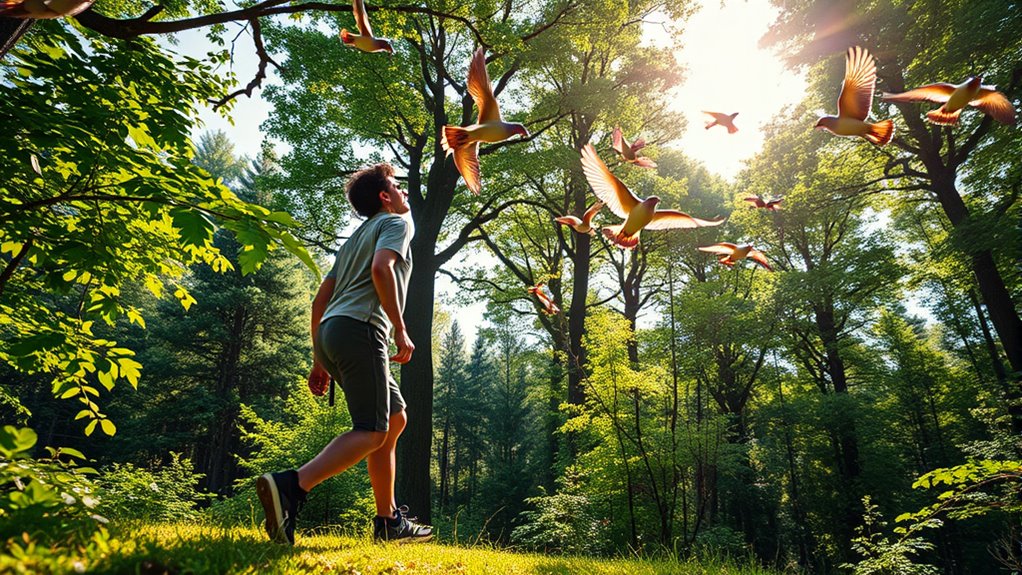
Engaging in wildlife watching naturally encourages you to move more, boosting your physical activity and overall fitness. Whether you’re walking through trails for birdwatching or adjusting your camera for wildlife photography, these activities keep you active. Learning birdwatching techniques sharpens your focus and engages your muscles as you scan trees or listen attentively. This active pursuit not only improves cardiovascular health but also strengthens your core and legs. Imagine feeling energized after a hike while capturing stunning shots or spotting rare birds. Here’s how wildlife watching elevates your fitness:
| Activity | Physical Benefit | Emotional Reward |
|---|---|---|
| Birdwatching | Improves balance and stamina | Sense of achievement |
| Wildlife photography | Enhances core strength | Connection with nature |
| Trail walking | Boosts cardiovascular health | Excitement of discovery |
| Observation pauses | Increases mindfulness | Inner peace |
Additionally, incorporating physical activity into your wildlife watching routine can lead to long-term health benefits. Regular outdoor activity not only fosters community engagement but also enhances your resilience and adaptability in various environments. Developing an awareness of nature conservation can deepen your connection and commitment to preserving these habitats for future generations. Being mindful of environmental awareness can also improve your overall appreciation for the ecosystems you’re exploring.
Cultivating Patience and Observational Skills
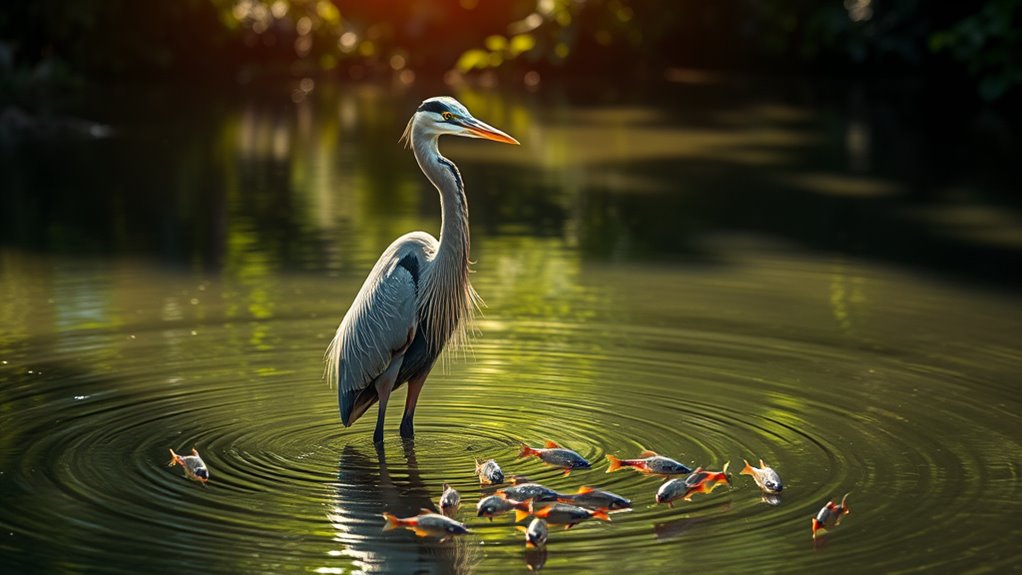
While physical activity gets you moving and keeps you fit, wildlife watching also sharpens your mind through patience and keen observation. This activity encourages mindfulness practice, helping you stay present and attentive. As you wait quietly, you develop patience, learning to accept delays and enjoy the moment. To enhance your skills, try:
- Focusing on details, like bird movements or sounds
- Practicing silent observation, avoiding distractions
- Developing patience by waiting calmly for wildlife to appear
- Using filtration techniques to maintain a clear and focused mind during extended periods of observation
Additionally, understanding educational toys can inspire your own patience and perseverance in pursuing hobbies. Engaging in mindful observation can also boost your mental clarity, enabling you to better process details and respond thoughtfully. Incorporating mindfulness practices can deepen your awareness and foster a greater sense of calm. These steps strengthen your patience development and observational skills. Over time, you’ll notice how your ability to stay focused improves, translating into daily life. Wildlife watching becomes a mindful practice that enriches your awareness and emotional resilience.
Inspiring Creativity and Artistic Expression
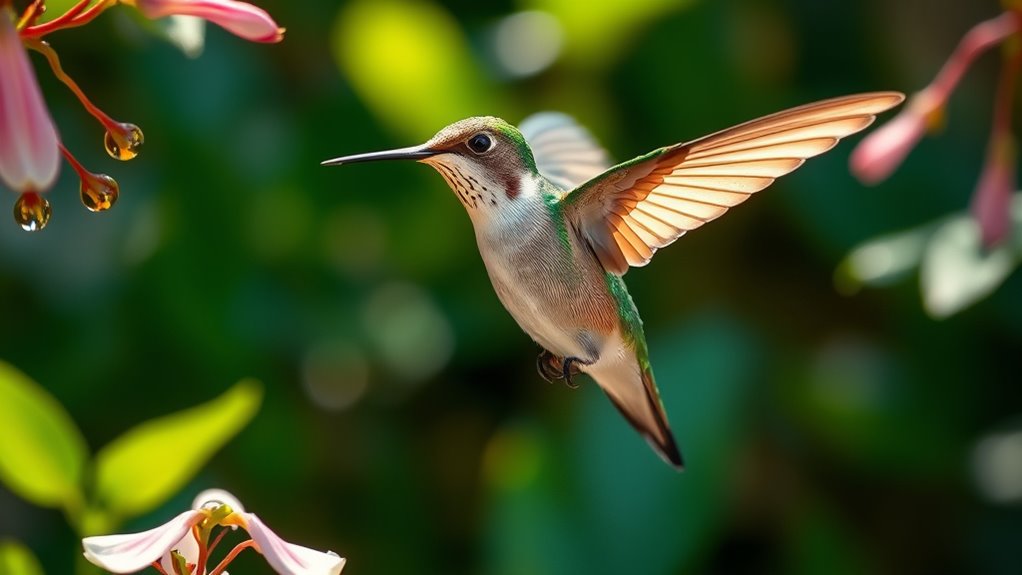
Wildlife watching can spark your creativity by showing you nature as an endless artistic muse. As you observe unique behaviors, you might find inspiration for your own artistic projects. Capturing moments creatively allows you to translate what you see into meaningful expressions. Engaging in ethical observation can deepen your appreciation and understanding of animal behaviors, enriching your artistic perspectives. Exploring the diverse costumes and accessories related to themed events can further broaden your creative horizons. Additionally, noticing variations in animal sleep patterns can inspire new ideas and themes in your artwork.
Nature as Artistic Muse
Nature’s intricate patterns, vibrant colors, and dynamic movements serve as endless sources of inspiration for artists and creatives. You can channel this inspiration through wildlife photography, capturing the beauty of animals in their natural habitats. The vivid scenes and textures you observe can spark new ideas and techniques in your artwork. Additionally, bird song appreciation invites you to focus on the subtle melodies and rhythms of nature’s symphony, fueling your creativity. Developing cultural intelligence can also help you appreciate the diverse ways people interpret and connect with nature across different cultures. Engaging with wildlife conservation efforts can deepen your understanding of ecosystems and inspire more meaningful artistic expressions that promote awareness.
Observing Unique Behaviors
Observing animals as they perform their unique behaviors can ignite your creativity and deepen your artistic expression. Witnessing unusual animal interactions, like a bird helping a wounded companion or insects performing intricate dances, sparks fresh ideas and perspectives. Rare species sightings offer a glimpse into extraordinary worlds, inspiring you to explore new themes and techniques in your art. These moments challenge your perception, encouraging you to see the natural world through a more imaginative lens. By paying close attention to these behaviors, you can translate the energy, motion, and emotion into sketches, paintings, or stories. The unpredictability of wildlife encounters fuels your curiosity and pushes your creative boundaries, making your artistic journey richer and more authentic. Incorporating positive thinking into your approach can help you embrace these spontaneous moments with confidence and enthusiasm. Additionally, understanding payment processing systems enhances your appreciation for the complexity behind the scenes, reminding you that even in nature, there are intricate mechanisms at work that support seamless experiences. Recognizing resources and tools available for wildlife observation can further enrich your experience, helping you access valuable information and enhance your engagement with the natural world. Embracing biodiversity hotspots can also introduce you to rare species that may inspire your artistic exploration.
Capturing Moments Creatively
Capturing moments in wildlife imagery transforms spontaneous animal behaviors into compelling works of art. When you engage in wildlife photography or creative journaling, you turn fleeting scenes into lasting impressions. To enhance your creativity, consider these ideas:
- Experiment with different angles and lighting to evoke emotion and mood.
- Use your camera to focus on details, like feathers or paw prints, highlighting the beauty in small things.
- Combine your photos and observations in a journal, pairing visuals with reflections or stories.
This approach not only sharpens your artistic skills but deepens your connection with nature. As you creatively document wildlife, you discover new perspectives and develop a unique voice in your storytelling. Let your imagination lead your exploration of the natural world.
Building Community and Shared Experiences
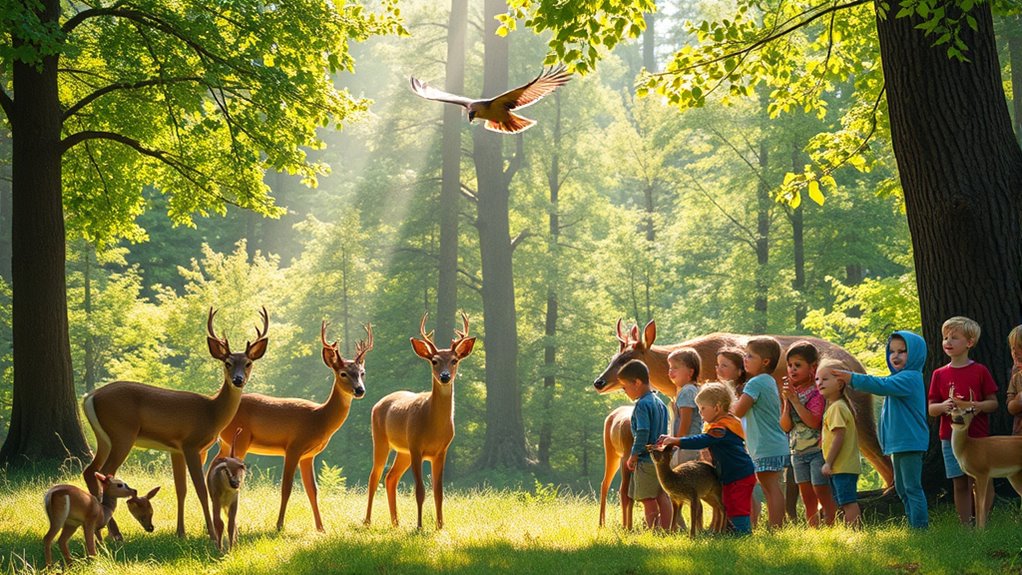
When you join wildlife watching groups, you connect with others who share your passion for nature. These shared experiences often lead to lasting friendships and a sense of community. Engaging with others outdoors makes every adventure more meaningful and memorable.
Connecting With Nature Groups
Joining nature groups offers a powerful way to build community and share memorable experiences with others who appreciate wildlife. By participating, you’ll connect with people who share your passion for bird watching and habitat preservation. These groups often organize outings, workshops, and conservation projects that deepen your understanding and engagement. Here are some ways these groups enhance your experience:
- Learn new skills – Improve your bird identification and habitat knowledge through expert-led sessions.
- Expand your network – Meet fellow enthusiasts and form friendships rooted in shared interests.
- Make a difference – Contribute to habitat preservation efforts, helping protect wildlife and their environments.
Being part of these groups enriches your appreciation for nature and fosters a sense of belonging within a passionate community.
Creating Lasting Friendships
Building lasting friendships through wildlife watching often begins with shared experiences that create strong bonds. Participating in birdwatching excursions or wildlife photography outings gives you opportunities to meet others who share your passion. As you observe and photograph wildlife together, conversations flow naturally, and trust develops. These shared moments foster camaraderie and a sense of community. Over time, you might find yourself exchanging tips on spotting rare birds or capturing perfect shots, deepening your connections. Wildlife watching provides a common ground that encourages collaboration and friendship beyond the initial outing. Whether you’re exploring a local park or a remote wilderness, these experiences can lead to meaningful relationships rooted in a mutual love for nature.
Frequently Asked Questions
What Are the Best Wildlife Spots for Beginners?
If you’re new to wildlife watching, start at local parks or wildlife refuges where bird identification is easier. These spots often have accessible trails, making it simple to observe birds and other creatures. Bring a binoculars and practice photography techniques like steadying your camera and focusing on movement. You’ll quickly learn to spot different species, and capturing their images enhances your experience and appreciation of nature’s beauty.
How Can Wildlife Watching Improve Mental Health Long-Term?
Seeing wildlife regularly can be a game-changer for your mental health. It fosters nature therapy, helping you unwind and find peace amidst chaos. Over time, this reduces stress, boosts your mood, and sharpens your focus. Wildlife watching encourages mindfulness, allowing you to reconnect with the world around you. Keep at it, and you’ll find that your mental well-being improves long-term, showing that sometimes, the best medicine is just a walk in nature.
What Gear Is Essential for Successful Wildlife Observation?
You need binoculars essentials like a lightweight, waterproof pair for clear views, and a reliable camera gear to capture wildlife moments. Pack a sturdy tripod for stability, extra batteries, and memory cards to avoid missing shots. A field guide or app can help identify species. Don’t forget comfortable clothing and a hat. With these essentials, you’ll enhance your chances of successful wildlife observation and create unforgettable experiences.
Are There Ethical Guidelines to Follow During Wildlife Watching?
Did you know that over 80% of wildlife populations are affected by human activity? That’s why following ethical considerations is vital for respectful observation. Always keep a safe distance, avoid loud noises, and don’t disturb animals in their natural habitat. Respectful observation ensures you don’t stress or harm wildlife, helping preserve ecosystems for future enjoyment. Responsible watching benefits both the animals and your experience.
Can Wildlife Watching Aid Conservation Efforts Locally?
Yes, wildlife watching can aid local conservation efforts by encouraging community engagement and promoting habitat preservation strategies. When you observe wildlife responsibly, you help raise awareness about the importance of protecting natural habitats. Your participation can motivate local initiatives, support policies aimed at conservation, and foster a sense of stewardship. By actively engaging with wildlife, you become an advocate for preserving ecosystems, ensuring the survival of species and the health of your community’s environment.
Conclusion
Wildlife watching is like opening a door to a world of endless wonder, enriching your life in ways you never imagined. It sharpens your mind, soothes your soul, and sparks your creativity—all while connecting you to the natural world’s vibrant tapestry. So, step outside and embrace these surprising adventures. Your journey with wildlife is a story waiting to unfold, adding color and meaning to every chapter of your life.







